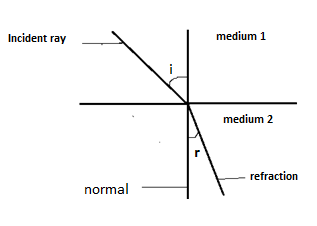
What is the relation between angle of incidence and angle of refraction in the glass?
Answer
489k+ views
3 likes
Hint: We have a law which gives relation of incident ray or incident angle and refracted angle with refractive index. Refractive index gives a relation between two pairs of mediums. It is also known as Snell –Descartes law and law of refraction. Using this law we can deduce Brewster angle also.
Complete answer:
The relation between angle of incidence and the angle of refraction was discovered by Dutch physicist Willard Snell in 1621 and is known as Snell’s law of refraction. This law gives important conclusions about refraction which states that:
1. At the point of incidence, the incident ray and refracted ray are on opposite sides of the normal. These three are in the same phase.
2. For a given pair of medium 1 and medium 2, the ratio of the sine of the angle of incidence to the sine of the angle of refraction is constant.

Mathematically, Snell’s law is given as,
Therefore Snell’s law gives a relation between angle of incidence
Note:
Bending of refracted rays depends on density of medium. Refracted ray bends towards the normal, when a light ray that is incident ray passes from a rarer medium to denser medium. If refracted ray bends away from the normal then incident ray must have passed from a denser medium to a rarer medium.
Now if
Then
Complete answer:
The relation between angle of incidence and the angle of refraction was discovered by Dutch physicist Willard Snell in 1621 and is known as Snell’s law of refraction. This law gives important conclusions about refraction which states that:
1. At the point of incidence, the incident ray and refracted ray are on opposite sides of the normal. These three are in the same phase.
2. For a given pair of medium 1 and medium 2, the ratio of the sine of the angle of incidence to the sine of the angle of refraction is constant.

Mathematically, Snell’s law is given as,
Therefore Snell’s law gives a relation between angle of incidence
Note:
Bending of refracted rays depends on density of medium. Refracted ray bends towards the normal, when a light ray that is incident ray passes from a rarer medium to denser medium. If refracted ray bends away from the normal then incident ray must have passed from a denser medium to a rarer medium.
Now if
Then
Latest Vedantu courses for you
Grade 11 Science PCM | CBSE | SCHOOL | English
CBSE (2025-26)
School Full course for CBSE students
₹41,848 per year
Recently Updated Pages
Master Class 9 General Knowledge: Engaging Questions & Answers for Success

Master Class 9 English: Engaging Questions & Answers for Success

Master Class 9 Science: Engaging Questions & Answers for Success

Master Class 9 Social Science: Engaging Questions & Answers for Success

Master Class 9 Maths: Engaging Questions & Answers for Success

Class 9 Question and Answer - Your Ultimate Solutions Guide

Trending doubts
Give 10 examples of unisexual and bisexual flowers

Draw a labelled sketch of the human eye class 12 physics CBSE

Differentiate between homogeneous and heterogeneous class 12 chemistry CBSE

Differentiate between insitu conservation and exsitu class 12 biology CBSE

What are the major means of transport Explain each class 12 social science CBSE

Why is the cell called the structural and functional class 12 biology CBSE




